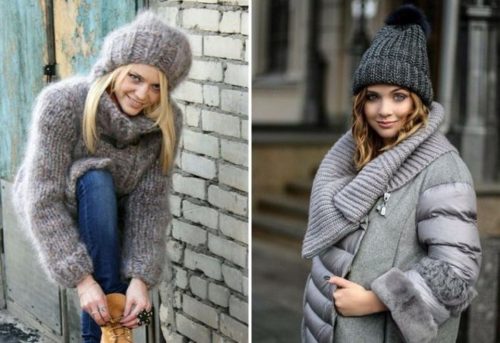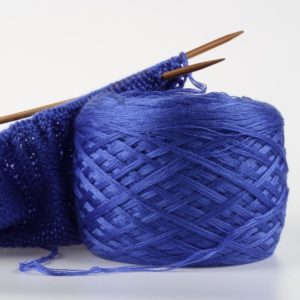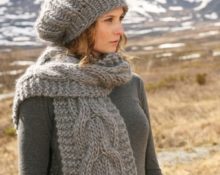Products knitted from thick yarn have not lost their relevance for several years. This yarn is suitable for making hats, scarves, blankets, clothing or toys. Products made from it look stylish and cozy. And the clothes keep you warm even in severe frost.

How to use the features of thick yarn when knitting?
Thick thread is called a skein of wool, where there are no more than 140 m of thread in 100 grams. Also on the threads there is an assessment of their thickness on a 6-point scale. Thick threads include those with a value of 5 or 6.
For knitting with thick yarn, use appropriate knitting needles. If the knitting needles are the right size, the product will be dense and warm. Needles with a larger diameter will create a loose knitting effect.
Craftswomen prefer to use for knitting smooth metal or wooden knitting needles, but with a coating. Cheap wooden knitting needles will catch the wool, and the product will turn out sloppy.

In stores thick yarn from different manufacturers differs in composition and purpose. In addition to the usual thick woolen threads, there are knitted ribbons. Products made from it are tough, so it’s better to take household items: baskets, rugs, pillows.
The unspun thread is called roving. This yarn is ideal for bulky blankets or warm clothes. Knitting with knitting needles is not so convenient; many craftswomen knit their products by hand. A significant disadvantage of rovings is its high price and high consumption.
What styles of hats can be knitted with thick yarn?
From thick yarn you can knit the same products as from regular threads. The only difference will be in the size of the knit and volume.

Looks most appropriate on hats and scarves standard elastic band. But on larger products you can also use patterns.
It is important to understand that large knitting on a product looks charming even without patterns, so you should not use any complex patterns.

In addition, some large threads tend to split into thin fibers. It will be difficult to knit intricate patterns from them.

What do you need to do before you start knitting?

Before knitting, yarn consumption is indicated on all products and diagrams. But when thick yarn is used, consumption increases significantly. Before starting knitting, it is recommended to knit a test sample size 20*20. The sample is then washed and the size and shrinkage are measured.
Some manufacturers indicate wool consumption for a certain knitting.
Second important point – items made from thick yarn stretch faster when used. This yarn has more weight and promotes stretching. Therefore, before starting knitting, the pattern is always reduced by 10–15%.
We knit a hat with a lapel for an adult
Beginning craftswomen can try knitting a hat with a lapel.
Winter in Russia lasts for more than one month, so you need to keep warm for a long time. A hand-knitted hat will save your budget. In addition, you will have a truly unique item in your wardrobe.
Considering the pattern for the hat – 1×1 elastic band. This pattern is suitable for beginners, looks stylish in large knitting and is functional as it is elastic.

What you need for the hat:
- 1-1.5 skeins of thick yarn;
- knitting needles 12–15 thick. You need either 5 knitting needles or one pair connected with a silicone cord.
For a head with a girth of 52–56 cm, the first row consists of 32 loops + 1 trailing loop, which is connected to the 1st loop.
The number of loops must be a multiple of 4.
The pattern begins to be knitted from the first row. To do this, knit 1 loop, purl the second, and alternate in a circle. The first and last loops are knitted together to close the hat into a circle.
When knitting with an elastic band, it is important that above the knit stitch there was a knit stitch, and above the purl loop there was a purl stitch.
To avoid getting confused in the rows, some craftswomen put a separator on the knitting needle. This could be a small piece of cardboard or a special marker from the store. You can, of course, count the loops yourself, but only if you are confident in your attentiveness.

If the hat is without a lapel, then knit 20 rows and begin to connect the loops. For a hat with a lapel, knit up to 35 rows.
When decreasing, two loops are knitted simultaneously, first purl and then knit. They continue this way until there is nothing left 10–12 loops.
The remaining loops are collected on a thread and pulled away. If you have a needle for felting, the tail can be felted carefully with the main part of the hat.
Children's hat for winter
It's always nice to please a child with a new thing.Sewing a baby hat is even faster; one skein and a few hours of free time will be enough.

Enough for a child's head 28 loops + 1 closing But children are all different, so it is recommended to knit a test sample and make sure the number of loops required.
Further 10–15 rows knitted with an already known elastic pattern 1×1, and then the loops are gradually reduced.

You can make a fluffy pompom from leftover yarn in a baby hat. To do this, cut out a rectangle 6–7 cm long and the height of the desired pompom. One tail of yarn is left free, and the rest is wound around a rectangle. You can use all the remaining yarn and make the pompom fluffy, or you can make it small. When the required volume is reached, thread a thread along the long side of the cardboard and tighten it. On the opposite side, the threads are cut and a pompom is formed. If necessary, trim the threads with scissors and sew the pompom to the hat.
Knitting a scarf or hat yourself is not only quick and easy, but also fun. You can choose the desired wool color, thread thickness and pattern yourself. In addition, a knitted hat will be an excellent gift for a loved one.


 0
0





